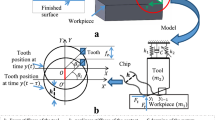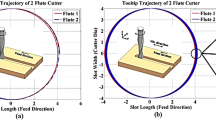Abstract
Fixed dynamometer is often used to collect cutting force data in plunge milling. The cutting force test signal is distorted because of the dynamic characteristics of the test system consisting of the workpiece and the dynamometer. Then the accuracy of cutting force coefficients based on experimental data analysis is affected. The inverse filtering technique is utilized to compensate for the measurement signal dynamically and verified by experiments. The influence of cutting parameters on cutting force coefficients is investigated by means of the nonlinear instantaneous milling force method. The results demonstrate that the cutting force coefficient has a nonlinear relationship with the feed per tooth and the spindle speed. An improved semi-discrete method is proposed for the machining feature of the plunge milling and utilized to predict the stability of the plunge milling. The measurement signal is analyzed by using the nonlinear method such as phase plane and Poincare section; the accuracy of the prediction of the stability lobe diagram is verified. The results demonstrate that the stability boundary of instantaneous cutting force coefficients is higher than that of the average cutting force coefficients. The research results provide theoretical guidance for the optimization of cutting parameters in the actual machining process.









Similar content being viewed by others
References
Ko JH, Altintas Y (2007) Time domain model of plunge milling operation[J]. Int J Mach Tools Manuf 47(9):1351–1361
Li Y, Liang SY, Petrof RC, Seth B (2000) Force modelling for cylindrical plunge cutting[J]. Int J Adv Manuf Technol 16(12):863–870
Damir A, Ng EG, Elbestawi M (2011) Force prediction and stability analysis of plunge milling of systems with rigid and flexible workpiece[J]. Int J Adv Manuf Technol 54(9-12):853–877
Zhuang K, Zhu D, Ding H (2018) An analytical cutting force model for plunge milling of Ti6Al4V considering cutter runout[J]. Int J Adv Manuf Technol 94(9-12):3841–3852
Liu X, Gao H, Yue C, Li R, Jiang N (2018) Investigation of the milling stability based on modified variable cutting force coefficients[J]. Int J Adv Manuf Technol 96(9-12):2991–3002
Budak E, Altintaş Y, Armarego EJA (1996) Prediction of milling force coefficients from orthogonal cutting data[J]. J Manuf Sci Eng 118(2):216–224
Wang JJJ, Zheng CM (2002) Identification of shearing and ploughing cutting constants from average forces in ball-end milling[J]. Int J Mach Tools Manuf 42(6):695–705
Gonzalo O, Beristain J, Jauregi H, Sanz C (2010) A method for the identification of the specific force coefficients for mechanistic milling simulation[J]. Int J Mach Tools Manuf 50(9):765–774
Altintas Y, Ber AA (2001) Manufacturing automation: metal cutting mechanics, machine tool vibrations, and CNC design[J]. Appl Mech Rev 54(2):84
Liu Z, He Z, Guo W, Tang Z (2016) A hybrid fault diagnosis method based on second generation wavelet de-noising and local mean decomposition for rotating machinery[J]. ISA Trans 61:211–220
Keskes H, Braham A, Lachiri Z (2013) Broken rotor bar diagnosis in induction machines through stationary wavelet packet transform and multiclass wavelet SVM[J]. Electr Power Syst Res 97:151–157
Cao H, Lei Y, He Z (2013) Chatter identification in end milling process using wavelet packets and Hilbert–Huang transform[J]. Int J Mach Tools Manuf 69:11–19
Yang D, Li H, Hu Y, Zhao J, Xiao H (2016) Vibration condition monitoring system for wind turbine bearings based on noise suppression with multi-point data fusion[J]. Renew Energy 92:104–116
Campatelli G, Scippa A (2012) Prediction of milling cutting force coefficients for aluminum 6082-T4[J]. Procedia Cirp 1(1):563–568
Scippa A, Sallese L, Grossi N, Campatelli G (2015) Improved dynamic compensation for accurate cutting force measurements in milling applications[J]. Mech Syst Signal Pr 54:314–324
Grossi N, Sallese L, Scippa A, Campatelli G (2015) Speed-varying cutting force coefficient identification in milling[J]. Precis Eng 42:321–334
Rubeo MA, Schmitz TL (2016) Mechanistic force model coefficients: a comparison of linear regression and nonlinear optimization[J]. Precis Eng 45:311–321
Wang M, Gao L, Zheng Y (2014) An examination of the fundamental mechanics of cutting force coefficients[J]. Int J Mach Tools Manuf 78(1):1–7
Grossi N, Sallese L, Scippa A, Campatelli G (2014) Chatter stability prediction in milling using speed-varying cutting force coefficients[J]. Procedia CIRP 14:170–175
Yue C, Gao H, Liu X (2017) Research on the stability of the machining process based on the dynamic cutting force coefficient[J]. J Mech Eng 53(17):193–201
Rafanelli F, Campatelli G, Scippa A (2015) Effects of cutting conditions on forces and force coefficients in plunge milling operations[J]. Adv Mech Eng 7(6):168781401558954
Ko JH, Altintas Y (2007) Dynamics and stability of plunge milling operations[J]. J Manuf Sci Eng 129(1):32–40
Lee P, Altintaş Y (1996) Prediction of ball-end milling forces from orthogonal cutting data[J]. Int J Mach Tools Manuf 36(9):1059–1072
Farkas M (1994) Periodic motions, ser[J]. In: Applied Mathematical Sciences. Springer-Verlag, New York, NY, p 104
Acknowledgments
The authors sincerely thank all the anonymous reviewers for their valuable suggestions on the improvement of our paper.
Funding
This work is supported in part by the National Natural Science Foundation of China (Grant No.51375127).
Author information
Authors and Affiliations
Corresponding author
Additional information
Publisher’s note
Springer Nature remains neutral with regard to jurisdictional claims in published maps and institutional affiliations.
Rights and permissions
About this article
Cite this article
Zhai, Y., Gao, H., Wang, Y. et al. Influence of cutting parameters on force coefficients and stability in plunge milling. Int J Adv Manuf Technol 104, 2513–2523 (2019). https://doi.org/10.1007/s00170-019-04036-y
Received:
Revised:
Accepted:
Published:
Issue Date:
DOI: https://doi.org/10.1007/s00170-019-04036-y




